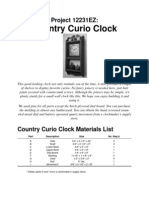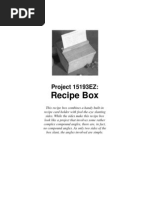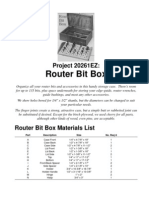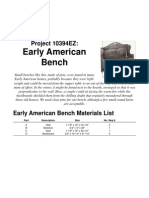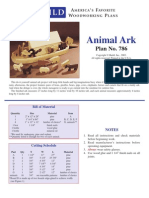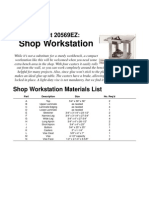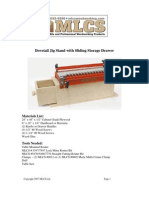0 ratings0% found this document useful (0 votes)
98 viewsPaper Towel Holder
Paper Towel Holder
Uploaded by
mchiovettaThis document provides plans and instructions for making an attractive oak paper towel holder. The holder consists of several circular pieces that fit together, with dowels inserted to guide the paper towel roll and prevent it from falling out. It is designed to overcome problems with standard plastic holders by being portable, suitable for table use, and preventing the entire roll from popping out during use. Detailed diagrams, materials list, and step-by-step instructions are provided to allow anyone to build their own functional and decorative paper towel holder.
Copyright:
© All Rights Reserved
Available Formats
Download as PDF, TXT or read online from Scribd
Paper Towel Holder
Paper Towel Holder
Uploaded by
mchiovetta0 ratings0% found this document useful (0 votes)
98 views5 pagesThis document provides plans and instructions for making an attractive oak paper towel holder. The holder consists of several circular pieces that fit together, with dowels inserted to guide the paper towel roll and prevent it from falling out. It is designed to overcome problems with standard plastic holders by being portable, suitable for table use, and preventing the entire roll from popping out during use. Detailed diagrams, materials list, and step-by-step instructions are provided to allow anyone to build their own functional and decorative paper towel holder.
Original Description:
Maderas construccion
Original Title
15157 Paper Towel Holder
Copyright
© © All Rights Reserved
Available Formats
PDF, TXT or read online from Scribd
Share this document
Did you find this document useful?
Is this content inappropriate?
This document provides plans and instructions for making an attractive oak paper towel holder. The holder consists of several circular pieces that fit together, with dowels inserted to guide the paper towel roll and prevent it from falling out. It is designed to overcome problems with standard plastic holders by being portable, suitable for table use, and preventing the entire roll from popping out during use. Detailed diagrams, materials list, and step-by-step instructions are provided to allow anyone to build their own functional and decorative paper towel holder.
Copyright:
© All Rights Reserved
Available Formats
Download as PDF, TXT or read online from Scribd
Download as pdf or txt
0 ratings0% found this document useful (0 votes)
98 views5 pagesPaper Towel Holder
Paper Towel Holder
Uploaded by
mchiovettaThis document provides plans and instructions for making an attractive oak paper towel holder. The holder consists of several circular pieces that fit together, with dowels inserted to guide the paper towel roll and prevent it from falling out. It is designed to overcome problems with standard plastic holders by being portable, suitable for table use, and preventing the entire roll from popping out during use. Detailed diagrams, materials list, and step-by-step instructions are provided to allow anyone to build their own functional and decorative paper towel holder.
Copyright:
© All Rights Reserved
Available Formats
Download as PDF, TXT or read online from Scribd
Download as pdf or txt
You are on page 1of 5
Project 15157EZ:
Paper Towel
Holder
The standard paper towel holder is an
uninspired piece of plastic that is normally
attached to a wall. It can hardly be consid-
ered portable or suitable for use on the
dinner table. Tearing off the towels usually
turns into a two-handed process as too
often the energetic one-handed approach
results in the entire roll popping out and
ending up in a sink full of dishwater or all
over the kitchen floor. This attractive paper
towel holder, in addition to overcoming
these problems, will fit in well with both
kitchen and dining room decors. We used
oak for all parts. If you can’t get oak dowel
stock locally, it can be ordered.
Paper Towel Holder Materials List
Part Description Size No. Req’d
A Base 9-3/4" dia. x 3/4" thick 1
B Top 9-3/4" dia. x 3/4" thick 1
C Stretcher Dowels 1/2" dia. x 12-1/8" long 5
D Guide Dowels 3/8" dia. x 12-1/8" long 2
E Base Pin 1-1/4" dia. x 3/4" long 1
F Lid 7" dia. x 3/4" thick 1
G Top Pin 1-1/4" dia. x 1-1/4" long 1
H Dowel Pin 1/4" dia. x 2" long 1
I Knob See detail. 1
Paper Towel Holder Complete Schematic
Paper Towel Holder Step-by-Step
Instructions
1. Edge join sufficient 3/4" stock to be able to cut the circles of Parts A, B, and
F.
2. Use a compass to scribe the three circles on the stock.
3. Use a band or jig saw to cut the circles.
4. Use double-faced tape to temporarily join Parts A and B.
5. Use a disc sander to true up the edges of Parts A and B.
6. Draw a concentric 8" diameter circle on the bottom of Part A.
7. Set a pair of dividers to the radius distance (4") to divide the circle into six
equal arcs.
8. Start at the diameter line intersection and “walk” the dividers around the
circle.
9. Use a drill press to drill 1/2" diameter holes 1-1/8" in depth at five of the six
points on the circle. Note: the holes should extend through Part A and
3/8" into Part B.
10. Put a mark 1/4" to each side of the sixth point scribed on the circle.
11. Drill 3/8" diameter holes 1-1/8" deep at the two marks.
12. Separate Parts A and B.
13. Draw a 6-3/8" diameter concentric circle on Part B.
14. Use a jigsaw to cut out the circle on the inside of the scribed line.
15. True the edges of Part F.
16. Rout a 1/4" deep by 3/8" wide rabbet around the bottom of Part F so it will
fit into the hole in Part B.
17. Use a router with a 1/4" rounding bit to round over the top edges of Parts A,
B, and F.
18. Sand all three parts thoroughly.
19. Use a wood screw to attach Part E to the base.
20. Drill a 1/4" diameter hole through part F and 3/4" into Part G.
21. Insert Part H into the hole in Parts F and G and glue into Part G.
22. Purchase Part I and attach to part F via Part H.
23. Cut Parts C and D to size.
24. Sand all parts completely.
25. Glue Parts C and D into the base disc, making sure they are flush with the
bottom.
26. Put a drop of glue on the top of each dowel and attach Part B. NOTE: Use
the glue sparingly and wipe off any excess immediately to avoid affect-
ing the stain finish.
27. Apply the stain of your choice.
28. Add a roll of paper towels, feeding the end through the two guide dowels
(Parts D).
These plans were originally published in Volume 8, Issue 3 of The Woodworker’s
Journal (Jan/Feb 1984, pages 46-47).
You might also like
- 8kg Washing Machine: Instruction ManualDocument28 pages8kg Washing Machine: Instruction ManualSharif AfifiNo ratings yet
- ClaimConsult Estimating - WTR Scope SheetDocument2 pagesClaimConsult Estimating - WTR Scope SheetRobert Keefer100% (1)
- Kenmore Washer ManualDocument41 pagesKenmore Washer ManualLawrence Koss100% (2)
- Pine Desk Organizer: Project 13782EZDocument6 pagesPine Desk Organizer: Project 13782EZBSulli100% (1)
- Old World Weather Forecaster: Project 14438EZDocument10 pagesOld World Weather Forecaster: Project 14438EZBSulli100% (1)
- Country Curio Clock: Project 12231EZDocument7 pagesCountry Curio Clock: Project 12231EZBSulliNo ratings yet
- Wall Hung Magazine and Book Rack: Project 14211EZDocument3 pagesWall Hung Magazine and Book Rack: Project 14211EZBSulliNo ratings yet
- Wall-Hung Telephone Cabinet: Project 11257EZDocument6 pagesWall-Hung Telephone Cabinet: Project 11257EZBSulli100% (1)
- EZJewelry ChestDocument9 pagesEZJewelry ChestBSulliNo ratings yet
- Chest of Drawers: Project 11819EZDocument7 pagesChest of Drawers: Project 11819EZBSulli100% (1)
- Barbecue Tray: Project 19830EZDocument4 pagesBarbecue Tray: Project 19830EZneilradcliffe3618No ratings yet
- Record and Tape Cabinet: Project 11185EZDocument8 pagesRecord and Tape Cabinet: Project 11185EZBSulliNo ratings yet
- Recipe Box: Project 15193EZDocument5 pagesRecipe Box: Project 15193EZBSulli100% (1)
- Router Bit Box: Project 20261EZDocument6 pagesRouter Bit Box: Project 20261EZBSulliNo ratings yet
- DIY Writing DeskDocument7 pagesDIY Writing DeskStephen MooreNo ratings yet
- Pine Cabinet: Project 11142EZDocument5 pagesPine Cabinet: Project 11142EZBSulliNo ratings yet
- Wood Working Plans - Toys - Rocking Horse PDFDocument6 pagesWood Working Plans - Toys - Rocking Horse PDFBen GerezNo ratings yet
- Cranberry Rake Box: Project 10571EZDocument3 pagesCranberry Rake Box: Project 10571EZBSulliNo ratings yet
- Writing Desk: Project 13586EZDocument7 pagesWriting Desk: Project 13586EZBSulliNo ratings yet
- EZEarly American BenchDocument7 pagesEZEarly American BenchBSulliNo ratings yet
- Barbecue Tray: Project 19830EZDocument4 pagesBarbecue Tray: Project 19830EZBSulliNo ratings yet
- Workshop Tote Box: Project 20466EZDocument3 pagesWorkshop Tote Box: Project 20466EZBSulli100% (1)
- Veneered End Table: Project 17901EZDocument4 pagesVeneered End Table: Project 17901EZBSulliNo ratings yet
- Wooden BookcaseDocument6 pagesWooden BookcaseCris CondeNo ratings yet
- Box of Shapes Toy: Project 18618EZDocument5 pagesBox of Shapes Toy: Project 18618EZBSulliNo ratings yet
- Router Bit Box 2 PartesDocument11 pagesRouter Bit Box 2 Partesapi-3830394100% (1)
- Mesa China CarpinteriaDocument7 pagesMesa China CarpinteriaMCarrillo_1971No ratings yet
- Stacking Desk Tray: Project 19874EZDocument4 pagesStacking Desk Tray: Project 19874EZBSulliNo ratings yet
- Leg Tapering Jig: Project 14585EZDocument5 pagesLeg Tapering Jig: Project 14585EZBSulliNo ratings yet
- Valentine Box: Project 10766EZDocument5 pagesValentine Box: Project 10766EZBSulliNo ratings yet
- Computer WorkstationDocument8 pagesComputer Workstation- yAy3e -100% (1)
- Closet OrganiserDocument5 pagesCloset OrganiserAnonymous 60esBJZIjNo ratings yet
- U-Bild: Plant TableDocument4 pagesU-Bild: Plant TableEmilian BalutaNo ratings yet
- Foldable Stool Reverse Engineering The Tallon StooDocument37 pagesFoldable Stool Reverse Engineering The Tallon StooEnrique Coronel100% (1)
- Contemporary Lamp: Project 15532EZDocument4 pagesContemporary Lamp: Project 15532EZBSulliNo ratings yet
- Child's Settle Table: Project 00000EZDocument5 pagesChild's Settle Table: Project 00000EZagustinrubio7946No ratings yet
- EZBagel SlicerDocument3 pagesEZBagel SlicerBSulliNo ratings yet
- Cut ListDocument12 pagesCut ListFrank CoxNo ratings yet
- Trestle Table and Benches: Project 18444EZDocument5 pagesTrestle Table and Benches: Project 18444EZAndre GaioNo ratings yet
- Small Colonial Bench: Project 10297EZDocument5 pagesSmall Colonial Bench: Project 10297EZmhein68No ratings yet
- Drill Press Organizer: Project 20068EZDocument5 pagesDrill Press Organizer: Project 20068EZBSulli100% (1)
- U-Bild: Animal ArkDocument8 pagesU-Bild: Animal ArkEmilian BalutaNo ratings yet
- U-Bild: China SideboardDocument8 pagesU-Bild: China SideboardEmilian BalutaNo ratings yet
- 4 X 4 Off RoaderDocument6 pages4 X 4 Off Roaderhulusi67100% (2)
- 2 - Woodworking Plans - OakplateDocument6 pages2 - Woodworking Plans - OakplatemacpatorNo ratings yet
- Plans Secret Jewelry BoxDocument7 pagesPlans Secret Jewelry Boxkincas67% (3)
- Drill Organizer and BatteryDocument6 pagesDrill Organizer and BatteryGhislainTremblayNo ratings yet
- Dresser PlanDocument11 pagesDresser PlanGsmHelpNo ratings yet
- Simple Elegance: A Table With Few Parts and Uncomplicated Joinery Proves That Less Is MoreDocument5 pagesSimple Elegance: A Table With Few Parts and Uncomplicated Joinery Proves That Less Is Moreanca mariaNo ratings yet
- Cut ListDocument11 pagesCut ListFrank CoxNo ratings yet
- Style StitchesDocument18 pagesStyle Stitcheschina_bella81100% (3)
- EZTowelbar W Glass ShelfDocument2 pagesEZTowelbar W Glass ShelfBSulliNo ratings yet
- How To Make A Cornhole BoardDocument4 pagesHow To Make A Cornhole BoardAndré VeigaNo ratings yet
- Blog TH Kitchenette Upload Part 1Document4 pagesBlog TH Kitchenette Upload Part 1Antonio Aranda CabreraNo ratings yet
- DIY Tutorial Cordless Drill Organizer Charge Station PlansDocument5 pagesDIY Tutorial Cordless Drill Organizer Charge Station PlansStanlei FernandaNo ratings yet
- Shop Workstation: Project 20569EZDocument3 pagesShop Workstation: Project 20569EZBSulliNo ratings yet
- ParquetDocument4 pagesParquetFernando FrayreNo ratings yet
- Jig - Horizontal Boring JigDocument3 pagesJig - Horizontal Boring Jigcorneliu.modilcaNo ratings yet
- Plans Dovetail Jig StandDocument6 pagesPlans Dovetail Jig Standhmam_88100% (1)
- U-Bild: Three-Piece Bedroom SetDocument8 pagesU-Bild: Three-Piece Bedroom SetEmilian BalutaNo ratings yet
- How to Make Picture Frames (Best of AW): 12 Simple to Stylish Projects from the Experts at American Woodworker (American Woodworker)From EverandHow to Make Picture Frames (Best of AW): 12 Simple to Stylish Projects from the Experts at American Woodworker (American Woodworker)Rating: 5 out of 5 stars5/5 (2)
- Jadwal Kitchen Crew Op - Februari 2022Document30 pagesJadwal Kitchen Crew Op - Februari 2022Fatih KhiqmiawatiNo ratings yet
- Packing List SamplerDocument2 pagesPacking List SamplerJuan Jose Coila P.No ratings yet
- Clipsominut Manual en ESDocument53 pagesClipsominut Manual en ESalvaro aquevequeNo ratings yet
- Um RosieresDocument33 pagesUm RosieresBenjaminNo ratings yet
- Standby PowerDocument3 pagesStandby PowerFawwazNo ratings yet
- Healthy Living Begins With Cleanhome: Product CatalogueDocument49 pagesHealthy Living Begins With Cleanhome: Product CataloguedhermioneNo ratings yet
- Hotel Opening Plan & ChecklistDocument15 pagesHotel Opening Plan & Checklisthareemhassan1310No ratings yet
- Tupig Is Made From Glutinous orDocument22 pagesTupig Is Made From Glutinous orPestilos JhonardNo ratings yet
- VIBROSCREEN Manaul - FullDocument26 pagesVIBROSCREEN Manaul - Fullvser190% (1)
- SH - Introduction To HEDocument11 pagesSH - Introduction To HEinesquinlanNo ratings yet
- DIVERSEY NAME Chemical Usgae Manual1Document7 pagesDIVERSEY NAME Chemical Usgae Manual1Arokiaraj Amalraj100% (1)
- Washing Machine Beko WTIK72151Document40 pagesWashing Machine Beko WTIK72151Jalil BouhdidNo ratings yet
- Homework Club Blanchardstown Dublin 15Document5 pagesHomework Club Blanchardstown Dublin 15tqkacshjf100% (1)
- Course Task 2 - Laboratory Module Week 1Document4 pagesCourse Task 2 - Laboratory Module Week 1BOBO GamingNo ratings yet
- Reading Comprehension:: Linda's Lovely HouseDocument2 pagesReading Comprehension:: Linda's Lovely HouseMercedes Fernández RamírezNo ratings yet
- TLEBPP Grade7 8 QTR2 Module3Part1-1Document16 pagesTLEBPP Grade7 8 QTR2 Module3Part1-1Jaydee Anne RiveraNo ratings yet
- Owner's ManualDocument27 pagesOwner's ManualSonaina KhanNo ratings yet
- 12 Page Built-In BrochureDocument12 pages12 Page Built-In BrochureneethukNo ratings yet
- ANJ - Sloveso To Be - DoplňovanieDocument2 pagesANJ - Sloveso To Be - DoplňovanieIveta SvedovaNo ratings yet
- For Beginners - Tartine Country RecipeDocument8 pagesFor Beginners - Tartine Country RecipeBrava PizzaNo ratings yet
- Cookery Grade 8 2021 22 ExamDocument2 pagesCookery Grade 8 2021 22 ExamAhnngie Pen100% (2)
- Ergo 2Document3 pagesErgo 2Arctic FoxNo ratings yet
- Ehs - Chemical Storage Area Inspection Checklist: Tower: Floor: Wing: Area/Location: Date: Audit TeamDocument12 pagesEhs - Chemical Storage Area Inspection Checklist: Tower: Floor: Wing: Area/Location: Date: Audit TeamLakshmi BalaNo ratings yet
- 4Product CatalogDocument20 pages4Product Catalogritesh bhoirNo ratings yet
- AARP - Home Maintenance - Guide - v19Document61 pagesAARP - Home Maintenance - Guide - v19mixhalo2013100% (1)
- SJPT521R-PT561R Om GBDocument7 pagesSJPT521R-PT561R Om GBerpinNo ratings yet
- Detergent Factory Feasibility StudyDocument72 pagesDetergent Factory Feasibility Studyfirehiwotmisganaw3No ratings yet





